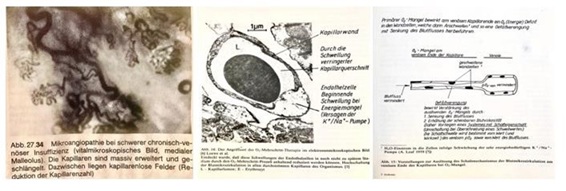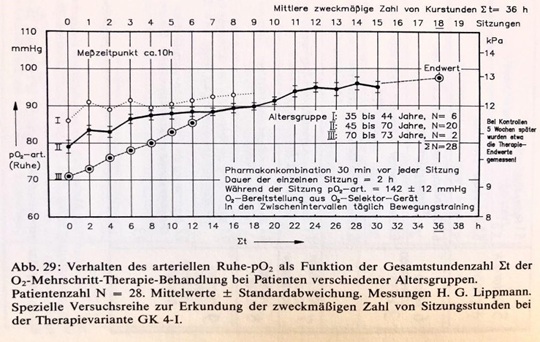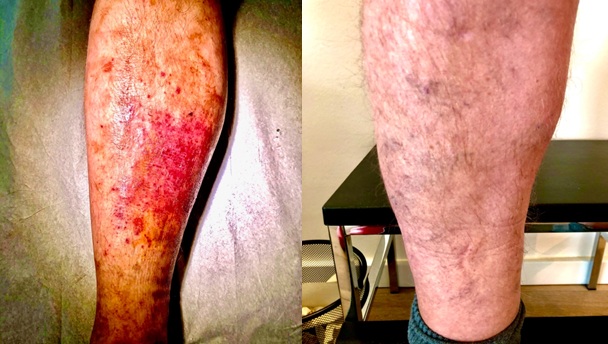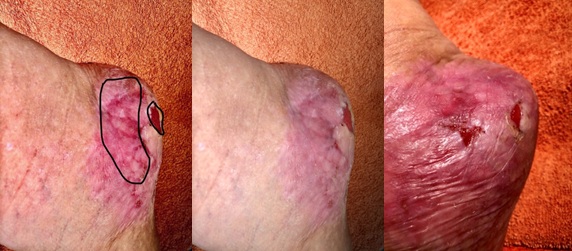
Saphenion®: Oxygen Multi-Step Therapy in Varicose Veins: Improvement of the Microcirculation- Our Prospective Study Results in 118 Cases Over 6 Months
*Corresponding Author(s):
Ulf Thorsten ZierauFounder And CEO Of SAPHENION®-Vascular Surgeon, Endovascular Specialist Artery, Phlebologist, Endovenous Specialist, Berlin / Rostock, Germany
Email:rostock@saphenion.de
Abstract
Oxygen multi-step therapy for Varicose Veins: Oxygen as an energy carrier, all mechanisms in the human organism during growth, its maintenance and its physical and mental activity require energy. This becomes particularly clear to the patient during cardiac work, breathing work in the lungs, skeletal muscles and intellectual work. The pathology of the microcirculation in the capillaries depends largely on the oxygen partial pressure and on the blood pressure in the supplying arteries and the high pressure in the draining veins.
Keywords
Improvement of capillary function; Microcirculation of legs; Micro-foam; Micro-foam - reduction of OVT; Oxygen multistep therapy after sealing varicose veins; Varicose veins; VenaSeal®; VenaSeal® closure system - reduction of foreign body reaction
Introduction
Oxygen multi-step therapy for Varicose Veins - the pathology of Microcirculation in the Leg Capillaries
It was only in 2019 that 3 scientists, the Americans Wiliam Kaelin and Gregg Semenza and the English Man Peter Ratcliffe, received the Nobel Prize in Physiology and Medicine-for their long-term scientific research work on the oxygen supply to human cells.
The three scientists found out how cells feel the different oxygen concentrations as well as react to them. They discovered the molecular control mechanisms that regulate the activity of genes in response to fluctuating amounts of oxygen [1].
This Nobel Prize award is also a late honor for Prof. Manfred von Ardenne and his team at the Dresden Ardenne-Institute of the same name. As early as 1977, the scientists at the institute Auf dem Weißen Hirsch at the mountains around the city Dresden had questions about the energetic supply of the cell energy balance, especially about the role of oxygen concentration in the cells, worked [1].
Basically, the oxygen multi-step therapy helps with many energy-intensive life processes. Defined as a naturopathic treatment in Germany, there are a number of effects [1].
- Improvement of the oxygen status: What oxygen therapy brings can be measured and felt!
- A special feature of the therapy: systemic long-term effects without side effects
- Oxygen can help: 80% of all complaints are due to a lack of oxygen in cellular respiration!
- Oxygen is a powerful material: a sudden increase in general mental and physical performance.
- Radiance and beauty - the skin also benefits greatly from oxygen
- Fit into old age: slowing down aging processes (anti-aging)
- One more: energy, vitality, endurance, defenses and concentration
- No hurdles: The application is very easy to implement
The varicose veins of the legs lead to a backflow of the venous blood into the lower leg. Both the deep veins and the skin veins are under high pressure. This pressure is passed back to the capillaries unhindered. Both muscle spasm electrodes and venules have no venous valves, and control of the venous blood in the microcirculatory area is not possible. This means that the capillaries are under further tension, in addition to the reduction in the oxygen partial pressure, the venous pressure also causes the capillary walls to swell and cause a pathological deformation of these microcirculatory vessels [2,3].
On the one hand swelling of the capillary wall due to reduced oxygen partial pressure in the arteries, swelling and deformation of the capillary walls due to high venous back pressure. We are dealing here with an identical pathological effect on the capillary wall due to two completely different causes (Figure 1).
 Figure 1: Oxygen therapy for varicose veins: swelling of the capillary walls and deformation due to high venous pressure (left picture), swelling due to insufficient oxygen partial pressure (picture middle and right).
Figure 1: Oxygen therapy for varicose veins: swelling of the capillary walls and deformation due to high venous pressure (left picture), swelling due to insufficient oxygen partial pressure (picture middle and right).
Therapeutical view: oxygen multi-steptherapy for varicose veins-What can we do?
It should be considered whether, in addition to the minimally invasive therapy of the varicose veins on the legs by means of micro-foam and catheter interventions (VenaSeal®, radio wave, laser), an accompanying treatment using oxygen multi-step therapy should be carried out [4].
The restoration of the varicose veins initially leads to a significant reduction in venous pressure in the entire venous tract up to the capillaries. The accompanying oxygen therapy generates a significant increase in the oxygen partial pressure with improved oxygen saturation the cells and thus also leads to a swelling of the microcirculatory vessels.
Two different therapy concepts with a clear effect synergy - improvement of the microcirculation in the legs (Figure 2).
We have decided to offer this accompanying therapy to our patients with immediate effect. We carry out this therapy parallel to the postoperative compression massage therapy. This massage therapy is carried out post op after every catheter intervention like VenaSeal®, radio frequency or micro-foam. The compression therapy lasts 25-30 minutes, the oxygen therapy is used over the entire course of the compression massage [5,6].
 Figure 2: Oxygen therapy for varicose veins: achievable increase in O2 - saturation with oxygen multi-step therapy.
Figure 2: Oxygen therapy for varicose veins: achievable increase in O2 - saturation with oxygen multi-step therapy.
Saphenion®: Oxygen multistep therapy for varicose veins - study design
We have been conducting a prospective randomized study over 10 months now to clarify the therapeutic effects of post-operative massage therapy and oxygen multi-step therapy. In the course of the last 10 months, 127 patients were initially treated with 30 minutes of massage and 30 minutes of SMT after the VenaSeal® - and every micro-foam intervention. Of these patients, 118 operated on continued the follow-up treatment for a further 4-6 weeks. Of 127 patients, 9 patients (7.1%) refrained from further treatments after the first SMT and continued to receive compression therapy. They were excluded from the study.
The remaining 118 patients received additional SMT in conjunction with compression therapy (3-7 sessions) after the vein glue and each micro-foam session. In addition, 23 patients (18.1%) wanted to continue the combination compression therapy / SMT after varicose vein therapy.
The clinical and sonographic examinations we have done at the first day, 14 days, 4 weeks and 3 months after therapy with the vein glue and micro-foam (Figure 3).
 Figure 3: Oxygen Multistep therapy for varicose veins: Clinical picture of a patient with multiple ulcers - after VenaSeal® therapy and then after a series of 3 weeks regular combination of massage therapy and oxygen multi-step therapy healing of ulcers.
Figure 3: Oxygen Multistep therapy for varicose veins: Clinical picture of a patient with multiple ulcers - after VenaSeal® therapy and then after a series of 3 weeks regular combination of massage therapy and oxygen multi-step therapy healing of ulcers.
Saphenion®: Oxygen multistep-therapy for varicose veins -Results of our study
We have been conducting this prospective study on the results of postoperative oxygen Multistep Therapy (SMT) for 6 months. After the therapy with the vein glue „VenaSeal®“, as well as after all micro-foam sessions, all participating patients are treated for 30 minutes using multi-chamber compression therapy and SMT. In addition to the changes in measurement technology, our main aim is to determine any clinical improvements immediately after the treatment of varicose veins with the various catheter systems.
Basically, we place 2 oxygen sensors before and after the massage and oxygen therapy- one on the toe and one on the finger. The 118 patients included in the test so far (average age: 56 years, 28-85 years) showed a pre therapeutic difference in the oxygen content on the finger compared to the measurement on the forefoot of 3-25% (96-74%). These sometimeconsiderable differences in the resting phase before the start of therapy alone suggest that an existing varicose vein on the legs can lead to a reduced oxygen content of the blood in the lower extremity. None of these patients had any signs of leg artery disease either.
After the 30-minute oxygen multi-step therapy, we were able to determine an increase in the oxygen content in the blood of up to 18% (82%-99%) when taking measurements on the fingers. But the effect was much clearer on the feet. There, almost complete compensation for the difference between the hand and foot that existed before the oxygen therapy was achieved. At the foot, increases in the oxygen content of up to 28% (72% to 99% oxygen) were measured.
The analysis of the total group of 118 patients showed an improvement in the oxygen content of 2-11% (up to 10% increase) in the younger patients (28-55 years of age). In the group of 55 - 85 years old patients, we saw an improvement in the bloodoxygen content of 5-35% (up to 27% increase) [7,8] (Figure 4).
 Figure 4: Oxygen multistep therapy for varicose veins: Clinical picture of a patient with multiple ulcers - after VenaSeal® therapy and then in a series of 3 weeks of regular combination of massage therapy and oxygen multi-step therapy.
Figure 4: Oxygen multistep therapy for varicose veins: Clinical picture of a patient with multiple ulcers - after VenaSeal® therapy and then in a series of 3 weeks of regular combination of massage therapy and oxygen multi-step therapy.
Saphenion®: Oxygen multistep therapy for varicose veins - Clinical experiences
The remaining 118 patients reported fewer post-operative complaints - feeling of tension, swelling, tightness - and unrestricted athletic and professional resilience. In the clinical examinations first day, 14 days, 4 weeks and 3 months after therapy with the vein glue and micro-foam, we only saw reddening along the treated vein in 6 patients (5.1%) (foreign body reaction according to VenaSeal®) - this is nearly one third less of this side effect compared to the overall group of all 1647 patients (3215 truncal varicose veins) treated so far with the vein glue (here 7,48% foreign body reaction). We saw also 2 patients (1,7%) with micro-foam induced phlebitis (OVT)!Side effects minimal - in two cases patients reported about post therapeutic coughing and allergic similar reaction after Oxygen multistep therapy. Other side effects were not reported or seen! In particular, no deep vein thrombosis or OVT was seen after micro-foam therapy and related massagetherapy!
According to these initial results from a comparatively small patient group of 118 patients, the advantages of the oxygen multi-step therapy coupled with massage therapy are already evident. It should be considered whether, in addition to minimally invasive therapy for varicose veins on the legs using micro-foam and catheter interventions (VenaSeal®, radio wave, laser), accompanying treatment using massage and oxygen Multi-Step Therapy (SMT) can generally be recommended to patients. We will definitely continue our research on this.
The rehabilitation of the varicose veins initially leads to a significant reduction in venous pressure in the entire venous flow right through to the capillaries. This process is clearly supported by the post-operative massage. The accompanying oxygen therapy also generates a significant increase in the oxygen partial pressure with improved oxygen saturation of the cells and thus also leads to a swelling of the microcirculatory vessels, an improved immunological reaction to the foreign bodies, bio-glue and sclerotherapy foam, and faster wound healing [7,8].
Saphenion® - Oxygen multistep therapy for varicose veins - Our therapeutic consequences / discussion
In addition to the special indications for vascular medicine-arteries, veins, microcirculation in all body regions - oxygen Multi-Step Therapy (SMT) also has very good effects in other diseases [9].
Although it is certainly not easy for a surgeon to use non-surgical therapy, we are now ready to use non-surgical therapies adjuvant to catheter interventions on the arterial and vein system in the sense of a holistic therapeutic approach [10].
The multi-step oxygen therapy is one of the effective adjuvant therapies that also provides the vascular specialist with non-surgical accompanying therapies to further improve the therapy results for our patients. In the past, oxygen multi-step therapy has certainly been somewhat underestimated and viewed as less effective. The importance of oxygen for tissues and cells has also been brought back into the light. Our own, still short experiences confirm the substantial additional effect of this therapy [7,8].
In addition to normalizing the venous pressure, the aim is to improve the oxygen partial pressure in order to improve the microcirculation in the legs in a sustainable and multi-functional way.
In our first results, a reduction of immunological tissue reactions, as well as immunologically induced cell reactions both to the vein glue VenaSeal® (5.1% to 7.48% = 31% reduction) and to the micro-foam OVT (1,7% to 3,2% of all patients) we saw a decreased OVT rate of 46,9% reduction. Together with the decongestion therapy through the 12 - chamber compression, a real to achieve faster healing with comparatively significantly fewer side effects and complaints. So, we have two different therapy concepts with a clear synergy of effects - improvement of the microcirculation in the legs [11-18].
Disclosure
The author did not have any potential conflict of interests.
Thanks to my nurses Nina, Madlin and Nancy for their cooperation and intensive work in these cases!
References
- Ardenne MV (1989) Wo hilft Sauerstoff-Mehrschritt-Therapie? BI-Wissenschafts-Verlag, Mannheim, Wien, Zürich, Germany.
- Fachverband Deutscher Heilpraktiker eV (2021) Oxygen multi-step therapy.
- Nishimura M (2016) High-flow nasal cannula oxygen therapy in adults: physiological benefits, indication, clinical benefits, and adverse effects. Respir Care 61: 529-541.
- Jan Osterkamp (2019) The oxygen sensor of life. Spektrum.de, Germany.
- Paracelsus (2021) ABC of naturopathy.
- Zeit Online
- Zierau U (2021) Oxygen Therapy in Varicose Veins: Improvement of the Microcirculation in the Legs-Casuistic. J Phlebol Lymphol 1: 1-3.
- Saphenion (2021) Saphenion®: Oxygen multi-step therapy for varicose veins - improving microcirculation in the legs / our study.
- https://www.spiegel.de/gesundheit/diagnose/nobelpreis-medizin-2019-wofuer-der-preis-vergeben-wurde-a-1290354.html
- Zierau, U Th, Lillie M, Wolfgang L (2020) Arteriovenous ulcers: the mixed ulcers-still the domain of arterial therapy? Acase report. J Clin Stud Med Case Rep 7: 1-5.
- Cousins JL, Wark PA, McDonald VM (2016) Acute oxygen therapy: a review of prescribing and delivery practices. Int J Chron Obstruct Pulmon Dis 24: 1067-1075.
- DocMedicus (2021) News about the coronavirus infection.
- Gunnar Frank (2021) Oxygen therapy.
- Zeit Online (1984) Health through the nose. Zeit Online, Germany.
- Saphenion (2020) SaphenionScience: Muscle veins – foot varicose veins.
- Saphenion (2021) Das offene Bein - eine lange Leidensgeschichte.
- SaphenionScience (2020) Practice for vascular diseases and venous center.
- von Ardenne M, Klemm W, Klinger J (1984) Double-blind study on the long-lasting improvement of physical endurance following oxygen-multistep-therapy. Z Alternsforsch 39:17-30.
Citation: Zierau UT (2021) Saphenion®: Oxygen Multi-Step Therapy in Varicose Veins: Improvement of the Microcirculation- Our Prospective Study Results in 118 Cases Over 6 Months. J Angiol Vasc Surg 6: 075.
Copyright: © 2021 Ulf Thorsten Zierau, et al. This is an open-access article distributed under the terms of the Creative Commons Attribution License, which permits unrestricted use, distribution, and reproduction in any medium, provided the original author and source are credited.

